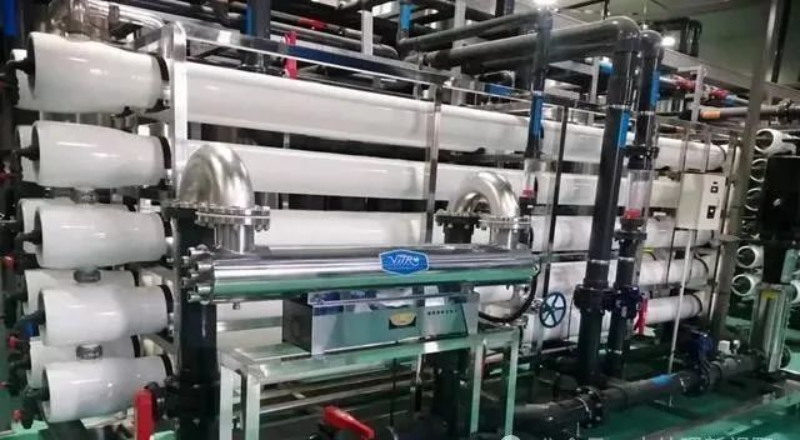(+86)0532-88988868
The free chlorine in the RO and NF influent water should be reduced to less than 0.05ppm in order to meet the requirements of polyamide composite membranes.
There are two pretreatment methods for chlorine removal, granular activated carbon adsorption and the use of reducing agents such as sodium sulfite.
In small systems (50-100gpm), activated carbon filters are generally used, and the investment cost is reasonable.
It is recommended to use high-quality activated carbon that has been pickled to remove hardness, metal ions, and a very low content of fine powder, otherwise it will cause pollution to the membrane.
Newly installed carbon media must be thoroughly rinsed until the toner has been completely removed, which usually takes a few hours or even days.

We can't rely on a 5μm security filter to protect the reverse osmosis membrane from toner contamination.
Carbon filters have the advantage of removing organics that can cause membrane fouling and are more reliable for the treatment of all influent water than the addition of chemicals.
However, the disadvantage is that the carbon can become feed for microorganisms, and bacteria breed in the carbon filter, resulting in biological contamination of the reverse osmosis membrane.
Sodium bisulfite (SBS) is a typical reducing agent for larger RO plants.
The solid sodium metabisulfite is dissolved in water to prepare a solution, the purity of the commercial sodium metabisulfite is 97.5-99%, and the dry storage period is 6 months.
SBS solution is unstable in air and reacts with oxygen, so it is recommended to use a 2% solution for 3-7 days and a solution of less than 10% for 7-14 days.
Theoretically, 1.47 ppm SBS (or 0.70 ppm sodium metabisulfite) is capable of reducing 1.0 ppm of chlorine.
The design takes into account the safety factor of the industrial brackish water system, and the addition rate of SBS is set to be 1.8-3.0ppm chlorine per 1.0ppm.
The injection port of the SBS should be upstream of the element and set at a distance of 29 seconds before entering the element. It is recommended to use an appropriate in-line agitator (static agitator).

SBS dechlorination: Na2S2O5 (sodium metasulfite) + H2O =2 NaHSO3 (sodium bisulfite) NaHSO3 + HOCl = NaHSO4 (sodium bisulfate) + HCl (hydrochloric acid)? The advantage of using SBS for NaHSO3 + Cl2 + H2O = NaHSO4 + 2HCl is that the investment in SBS is less than that of carbon filters in large systems, and the reaction by-products and residual SBS are easy to be removed by RO.
The disadvantages of SBS dechlorination are the need to manually mix small volumes of chemicals, the increased threat of chlorine to the membrane when the dechlorination system is not designed with adequate monitoring and control instruments, and in a few cases, sulfur-reducing bacteria (SBR) are present in the influent water, and the sulfurous acid will become bacterial nutrition to help bacteria multiply.
SBR is usually found in shallow well water in anaerobic environments, where hydrogen sulfide (H2S) is present as a metabolite of SBR.
The dechlorination process can be monitored using free chlorine monitors to monitor the concentration of residual sulfite, as well as ORP monitors.
The recommended method is to monitor the concentration of residual sulfites to ensure that there is enough sulfite to reduce chlorine.
Most commercial chlorine monitors have a pick-up concentration of 0.1 ppm, which is the upper limit of residual chlorine for CPA membranes. The direct use of ORP monitors to monitor sulfite concentrations is unreliable, and it is difficult to predict the baseline change of such an instrument for determining redox potential in water.
The chlorine resistance of CPA membranes is about 1000-2000ppm hours (salt permeability is doubled), and 1000ppm hours is equivalent to 3 years of operation at 0.038ppm residual chlorine.
It is important to note that in some cases chlorine resistance is found to be greatly reduced by increased temperature (above 90 degrees Fahrenheit), increased pH (above 7), and the presence of transition metals (e.g., iron, manganese, zinc, copper, aluminum, etc.).

The chloramine resistance of the CPA membrane is about 50,000-200,000 ppm hours (a significant increase in salt permeability occurs), which is equivalent to 1.9-7.6ppm of chloramine in the RO feed water, and the membrane can operate for 3 years.
Similarly, the membrane's ability to resist chloramines changes as temperature increases, pH decreases, and transition metals are present.
Somewhere on a tertiary wastewater treatment plant, it was found that the desalination rate of the membranes dropped from 98% to 96% in 2-3 years at a chloramine concentration of 6-8 ppm feed water.
Designers should note that dechlorination after chloramination is necessary. Chloramine is the product of mixed chlorine and ammonia, and the degradation of the membrane by free chlorine is much stronger than that of chloramine, and free chlorine will be present when the ammonia amount is insufficient.
Therefore, the use of excessive amounts of ammonia is critical, and system monitoring is to ensure this.


